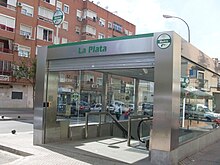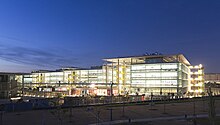Districts and neighbourhoods of Seville
Principal tourist attractions are located here, such as the cathedral, the Alcázar, the Torre del Oro, the City Hall, the Palace of San Telmo, the Archivo General de Indias and the Metropol Parasol.
[2] The University of Seville is mainly based in the former Royal Tobacco Factory in the south of the Casco Antiguo, the setting to the story and opera Carmen.
The Isla Mágica amusement park is on the island, as is the 60,000-seater Estadio de La Cartuja, built for Seville's unsuccessful bids for the 2000[5] and 2004 Summer Olympics.
[6] Neighbourhoods: Macarena is the traditional and historical name of the area of Seville located north of the Casco Antiguo on the eastern bank of the Guadalquivir.
Nowadays, La Macarena is the name of the neighborhood placed on both sides of the north city wall, but also a much bigger administrative district of Seville.
It is the second focal point of the city, and is home to a number of important sites including Santa Justa, Seville's major train station, with high-speed links via the AVE to Madrid, Córdoba, and Cadiz.
The Estadio Ramón Sánchez Pizjuán is home to Sevilla FC, one of Seville's two football teams in the top flight of La Liga.
Seville's modern port is in the southern tip of this district, having moved south from the neighbourhood of El Arenal in the Casco Antiguo in the 17th century.












